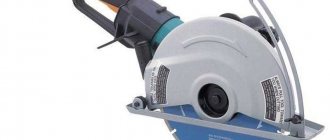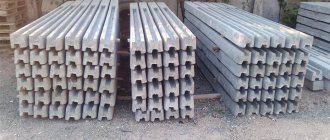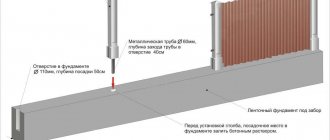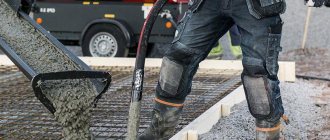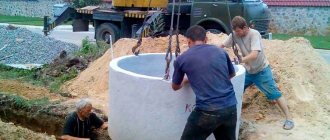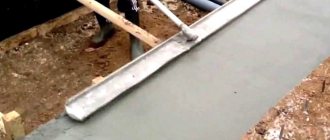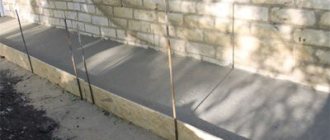- 1 Types of gutters 1.1 Suspension device
- 1.2 Gutter structures with jibs
- 1.3 Tray for truss-type concrete mixture
Gutters are a structure for draining or mechanically transporting liquid to the desired location. Such a device is a useful, effective assistant both in everyday life and in industrial conditions, in the road system, and the construction industry. It is the construction type of gutters that will be discussed. A construction gutter for concrete is a simple design that you can actually make with your own hands. With such a gutter it is possible to ensure high-quality, uniform placement of concrete mortar during the construction of the foundation for a building.
Types of gutters
There are several types of gutters for pouring concrete:
Return to contents
Hanging device
Return to contents
Gutter structures with jibs
Diagram of a trench for pouring concrete.
Return to contents
Truss-type concrete mix tray
The simplest mechanism for delivering concrete to the foundation site of all those listed. It is a design in which the lower edge of the concrete conveyor is attached to a support.
Return to contents
Concrete tray
Most often, a tray for receiving concrete is made of boards, since the iron structure is very heavy, working with it requires considerable strength and skill. The wooden tray is lightweight, quickly assembled on site, and can be made of any size to fit a specific formwork.
Kawabanga! Road slabs
To make a tray, take a wide board.
If the length of one board is not enough, the tray can be extended with a second board, fastening them from below with scraps of plank using self-tapping screws. They also increase the width by screwing a block of the required size to the side of the ribbing.
The height of the side walls will be enough 20 cm. If there is no one board of this width, then you can connect two 10 cm wide. They are connected to each other with self-tapping screws through small pieces of plank.
The next step is to screw the sides with self-tapping screws to the bottom board.
The concrete receiving tray is almost ready.
To prevent the sidewalls from moving apart under the weight of the concrete mixture, they are fastened on top with bars at a short distance.
The concrete tray is ready. Before starting work, it is advisable to moisten its surface with water to reduce the friction force.
If you liked the article, share it on social networks.
Mixer weight including concrete
Since the mixer weighs a lot, it requires certain characteristics for the road. Even if a BELAZ loaded with sand is driving along the road, this does not mean that a concrete truck will pass there just as successfully, because its weight increases several times.
If asphalt or a slab is laid, then you can drive on such a surface. In the case of off-road delivery, it is worth adequately assessing the capabilities of special equipment.
The price of concrete mixers (machines) depends on a number of factors. In any case, this special equipment is not cheap, therefore, when choosing an option that meets all the needs and operating conditions, you will need to spend time studying the market and delve into the features of these vehicles.
In the event that the mixer has been idle for a long time, or its operation has been carried out improperly, then due to the concrete that has hardened on the stacks, its volume will be noticeably reduced, for example, in a 5 “cube” mixer you may receive only 4 “cubes” of solution . Therefore, when ordering, choose a clean, frequently used mixer. The size of the mixer depends on the volume of the device, as well as on the chassis manufacturer. Currently, Kamaz, Ural and ZIL, Cifa, Diecil, Liebherr, Schwing Stetter, Al-KO, HAINUO equipment are in special demand.
Leading Russian manufacturers are:
Particular emphasis should be placed on imported mechanisms, when assembling which preference is given to our own automobile chassis. This applies to Belarusian MAZs and BelAZs, Italian Iveco, American Fords, German Mercedes, Japanese Mitsubishi and Nissan, and Korean Daewoo.
And finally, a simple piece of advice to avoid getting into trouble when ordering concrete and not being deceived in the amount of solution. One “cube” of concrete is unloaded in 10 minutes, therefore, it will take 50 minutes to unload 5 “cubes”. And if you have the opportunity, just check the weight of the mixer you ordered.
Materials, tools, procedure
The dimensions of the future product are taken based on the specific distances from the planned installation of the mixer or concrete mixer to the farthest point of the structure being poured.
In private low-rise housing construction, the length of the tray usually does not exceed 12 meters. The width of the tray is taken to be the “width” of a shovel plus 5 centimeters on each side (usually 300 millimeters), the height of the wall is the width of the existing edged board 150-200 millimeters.
The following materials and tools will be required:
In order to save on expensive galvanized iron, you can independently plane the side of the boards along which the concrete will be transported as smoothly as possible. For these purposes you will need a plane or jointer.
Operating procedure
- Depending on the width of the existing boards, the bottom of the tray box is assembled - 4 (150 mm) or 3 (200 mm) boards in a row are connected into an “end” with an overlay from the same board nailed to the underside of the bottom of the box. For strength and reliability, also on the bottom side of the box with a step of 600-800 mm to the bottom of the box, reinforcing bars 40x40 mm are nailed across;
- The walls of the tray are nailed to the sides of the bottom of the box, and best of all, the walls of the tray are screwed with self-tapping screws, so as to form a U-shaped structure;
- The bottom of the tray is covered with galvanized (roofing) iron, or is not covered if the boards are carefully planed;
- For reliability and strength, the walls of the tray are “bandaged” with 40x40 bars in increments of 0.8-1 meter.
The concrete transport tray itself can be considered ready for use. But there is one caveat. In order for the material to move into the formwork from an automixer or concrete mixer as independently as possible, it must have a slope to the soil surface of 5-15 degrees (for “liquid” concrete) and 20-30 degrees (for thick concrete).
In addition, the concrete tray should not bend under its own weight and the weight of the concrete. This can be achieved in several ways: pin up available materials under the tray (foam blocks, boxes, bricks, etc.) or spend a little time and knock down special triangular trestle supports of different heights from 50x50 mm timber and lay the tray on them as if on a bed.
Preparing to make a gutter
When manufacturing a device for transporting concrete, the following must be taken into account:
- The structure must connect the concrete mixer container with the formwork of the future foundation.
- It must be at a certain angle, which will allow the mixture to flow freely under the influence of its own weight to the desired location.
Kawabanga! How to build a concrete cellar
To make the structure you will need the following tools:
- Hacksaw or saw.
- Yardstick.
- Bulgarian.
- Hammer.
- Square.
- Screwdriver.
Materials to be prepared:
- Edged board 25x120 mm.
- Nails or screws.
- Linoleum, tin or plastic film.
- Blocks or timber for supports.
Manufacturing process
The gutter manufacturing technology is not particularly complicated. The principle of operation resembles the construction of a form for a foundation.
- We assemble the bottom of the gutter, connecting the boards with end plates from the same boards, nailing the material from below;
- In order to add strength, we fix it across the board with reinforcing bars in increments of 0.6-0.8 m, also from below;
- We nail the sides or screw them with self-tapping screws, creating a U-shaped model;
- We cover the bottom of the element with roofing iron if the boards are not planed;
- We strengthen the walls with beams in increments of 80-100 cm;
- Install the gutter in the right place;
- We support it with gas silicate blocks and measure the angle.
From the ground level the device is 5-15 degrees for a thin solution and 20-30 degrees will be needed for dense concrete. Then the solution from the mixer or concrete mixer, when it gets into the tray, will move along the riverbed on its own.
Making a gutter
The technology for making a concrete gutter with your own hands is not a particularly complicated process. The principle of its creation is exactly the same as when erecting formwork on a foundation.
Scheme of pouring a strip foundation.
- It is necessary to take an edged board measuring 25x150 mm and put together a “U-shaped” structure from it, the sides of which should be high enough so that the concrete mass does not stagnate.
- To make concrete flow easily, the inner surface of the gutter is lined with tin, linoleum or ordinary polyethylene, which will reduce the adhesion of the material.
- After the foundation gutter is made, it is installed in the desired location and supported by 4 support points. A good option would be to use gas silicate blocks for such purposes, which will prevent the structure from destruction.
In some cases, concrete is unloaded using a mixer into a special bunker and only then used for its intended purpose.
Why do you need a gutter?
Concrete solution comes from a concrete mixer there. The recommended length of the device is 1.2-1.5 m, then the concrete will be distributed evenly over the formwork. This is possible by providing free access to all areas of the building, including the most inaccessible ones.
Concrete delamination is prevented - without using this product, the thick solution will concentrate in the pouring area, and the liquid mass will spread over other areas. The correct approach to work will extend the life of the foundation by improving the quality of installation.
The gutter will reduce the mechanical impact on concrete - there will be no need to use shovels, and the work process will speed up.
Device requirements
Formwork diagram for the foundation.
In order for the supply of concrete mass during the construction of the foundation to be as uniform and homogeneous as possible, the gutters must meet certain requirements that apply to them:
The slope of the gutter must remain unchanged throughout the entire period of work during the construction of the foundation of the house. If this condition is not met and the angle of inclination, for example, decreases, then the speed of passage of the concrete mass will also decrease.
The angle of inclination of the gutter relative to the horizon must have a certain size, an increase in which will lead to the concrete mass being divided into parts. The reason for the change in the size of the angle of inclination may be the consistency of the concrete and the degree of its delivery distance.
Solutions of a more liquid consistency, supplied over a short distance, allow gentle slopes; for longer distances, steeper gutters are appropriate.
Kawabanga! What is your attitude towards pressed concrete pillars?
Two types of concrete mixers
Continuous cycle and cyclic type. The cyclic model is much more convenient to use. It works in three stages: loading concrete, mixing and unloading.
There are two types of cyclic concrete mixers based on the mixing principle: gravity and forced. The forced option involves mechanical mixing, in contrast to gravitational mixing, which works on the principle of falling mixture.
During the process, the concrete rises up to a limiting point, after which it falls down, simulating rotation. The properties of the finished solution can be changed throughout the process by changing and adjusting the angle of inclination.
The huge advantage of such concrete mixers is that they allow you to use material of any quality and density. Gravity models, which are very economical, are recommended to be used if the quality of the material produced is important. Forced-type mechanisms with a fixed bowl can ensure the production of the most uniform material possible. Using them, you can obtain absolutely any molding compositions and mixtures of different densities. If you use all components of approximately the same quality, you can obtain a high-quality material, but if the proportions are not observed, the quality of the product will noticeably deteriorate. This type is not economical, as it consumes a large amount of energy.
Nowadays, renting this equipment in Russia is quite popular. In Russia, renting them is not a problem, because this type of service is widespread, the cost is quite low, and you can rent absolutely any type of concrete mixer of your choice. Such services are used not only by private workers, as mentioned earlier, but also by builders of garages, fences and private houses.
Preparing to make a gutter
When manufacturing a device for transporting concrete, the following must be taken into account:
- The structure must connect the concrete mixer container with the formwork of the future foundation.
- It must be at a certain angle, which will allow the mixture to flow freely under the influence of its own weight to the desired location.
To make the structure you will need the following tools:
- Hacksaw or saw.
- Yardstick.
- Bulgarian.
- Hammer.
- Square.
- Screwdriver.
Materials to be prepared:
- Edged board 25x120 mm.
- Nails or screws.
- Linoleum, tin or plastic film.
- Blocks or timber for supports.
Preparation of materials and tools for creating a gutter
When producing a transport mechanism for a concrete composition, pay attention to some points:
- This device must be in close contact at one end with the mixer, at the other with the formwork, thus connecting them.
- Install the device with a certain angle of inclination so that it is easier for the concrete under its own weight to flow down the gutter into the formwork.
Tools that may be needed at work.
To create such a mechanism, you will need the following tools:
- hacksaw;
- roulette;
- hammer;
- screwdriver;
- square;
- Bulgarian.
To do this you will need to prepare the following materials:
- board measuring 2.5/12 cm;
- a piece of polyethylene, linoleum or tin;
- timber or block as a support;
- nails (you can use screws).
Return to contents
Features of using the equipment
Using a bucket to deliver concrete to a construction site
Before getting acquainted with the types of containers for supplying concrete, it is worth determining what they are needed for and the advantages of the equipment.
Concrete buckets are used:
The solution must be supplied to the container under certain conditions.
These include:
- Ability to carry out work at a relatively low speed;
- The need for equipment to lift the tub;
- Possibility of delivering the train to the loading site;
- Several workers must unload this bunker.
When doing monolithic construction with your own hands, such a container is not always needed - modern stationary concrete pumps easily supply the solution over hundreds of meters.
Even systems with smaller capacities mounted on a truck chassis can perfectly cope with delivering the composition to formworks located at a height of up to 30 meters. But the cost of such a process is quite high.
Construction of concrete mixers
Mixer device
On cars, gravity-driven reversible concrete mixers with a pear-shaped drum are used. The drum must be inclined to the horizontal plane at an angle of 10-15 degrees.
There are helical blades inside the container. When the drum rotates in one direction, they ensure mixing of the solution, and when rotated in the other direction, the solution is completely unloaded.
It should be noted that modern concrete mixer trucks are equipped with a water supply system, which will allow the drum to be flushed of the remaining mixture. They may also have functions such as weighing and dosing. This allows you to prepare high-quality concrete with certain technical characteristics.
Concrete mixer based on a KamAZ vehicle
Platform
Serial trucks are usually used as platforms. Among domestic vehicles, KAMAZ vehicles are the most popular. Moreover, they have become widespread not only in the CIS countries, but also beyond their borders.
Also, KrAZ and MAZ vehicles are often used as platforms for concrete mixers. Among foreign brands, Iveco, MAN, Scania, etc. equipment are very popular.
Types of devices
Types of equipment for concrete Such equipment is used to supply concrete mortar to the formwork or to the place where it is laid in small portions.
Concrete bunkers are available in two types:
Bucket glass for concrete
Universal products can be equipped with a sleeve.
Bucket shoe for concrete
Both options are used if unloading equipment is available. Such buckets for concrete mortar are produced in small volumes: from 0.5 m³ to 3 m³. This allows you to move structures with any mobile crane or manipulator.
Sizes of structures for different volumes
How to properly lay concrete?
During the process of laying the concrete mixture for the construction of the foundation, it is carefully compacted using deep vibrators. Tamping can also be done using ordinary steel reinforcement. The concrete composition is compacted until air bubbles disappear, which negatively affect the cast structure of the concrete base for buildings and structures. After removing air bubbles, begin leveling the top layer of the base using a trowel.
In some cases, to achieve a good result, you should not save on building materials and equipment, but use automated mechanisms that allow you to lay high-quality concrete mortar.


